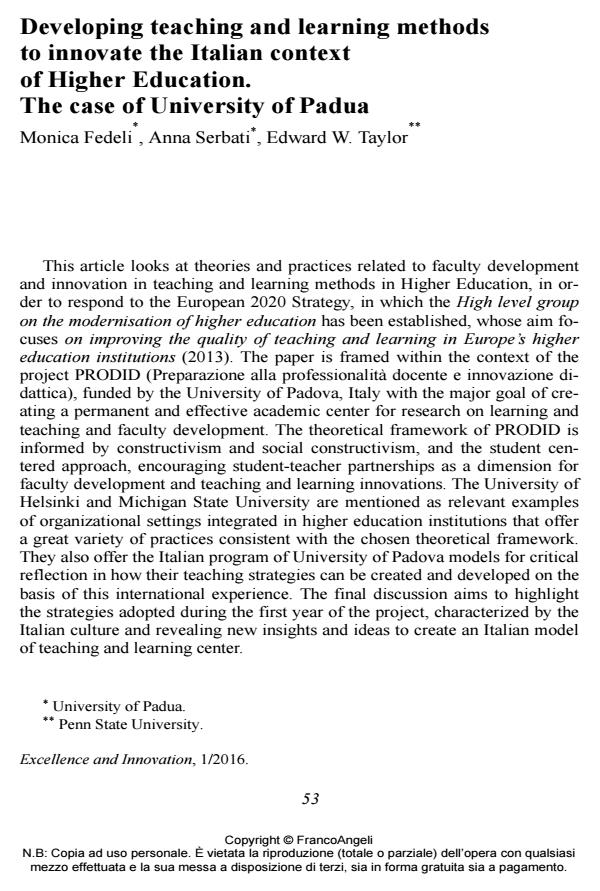Developing teaching and learning methods to innovate the Italian context of Higher Education. The case of University of Padua
Journal title EXCELLENCE AND INNOVATION IN LEARNING AND TEACHING
Author/s Monica Fedeli, Anna Serbati, Edward W. Taylor
Publishing Year 2016 Issue 2016/1
Language English Pages 18 P. 53-70 File size 71 KB
DOI 10.3280/EXI2016-001004
DOI is like a bar code for intellectual property: to have more infomation
click here
Below, you can see the article first page
If you want to buy this article in PDF format, you can do it, following the instructions to buy download credits

FrancoAngeli is member of Publishers International Linking Association, Inc (PILA), a not-for-profit association which run the CrossRef service enabling links to and from online scholarly content.
This article looks at theories and practices related to faculty development and innovation in teaching and learning methods in Higher Education, in order to respond to the European 2020 Strategy, in which the High level group on the modernisation of higher education has been established, whose aim focuses on improving the quality of teaching and learning in Europe’s higher education institutions (2013). The paper is framed within the context of the project PRODID (Preparazione alla professionalità docente e innovazione didattica), funded by the University of Padova, Italy with the major goal of creating a permanent and effective academic center for research on learning and teaching and faculty development. The theoretical framework of PRODID is informed by constructivism and social constructivism, and the student centered approach, encouraging student-teacher partnerships as a dimension for faculty development and teaching and learning innovations. The University of Helsinki and Michigan State University are mentioned as relevant examples of organizational settings integrated in higher education institutions that offer a great variety of practices consistent with the chosen theoretical framework. They also offer the Italian program of University of Padova models for critical reflection in how their teaching strategies can be created and developed on the basis of this international experience. The final discussion aims to highlight the strategies adopted during the first year of the project, characterized by the Italian culture and revealing new insights and ideas to create an Italian model of teaching and learning center.
Keywords: Faculty development; teaching and learning methods; teaching and learning centre.
- Entrepreneurship as a Special Pathway for Employability Carlo Terzaroli, in New Directions for Adult and Continuing Education /2019 pp.121
DOI: 10.1002/ace.20346
Monica Fedeli, Anna Serbati, Edward W. Taylor, Developing teaching and learning methods to innovate the Italian context of Higher Education. The case of University of Padua in "EXCELLENCE AND INNOVATION IN LEARNING AND TEACHING" 1/2016, pp 53-70, DOI: 10.3280/EXI2016-001004